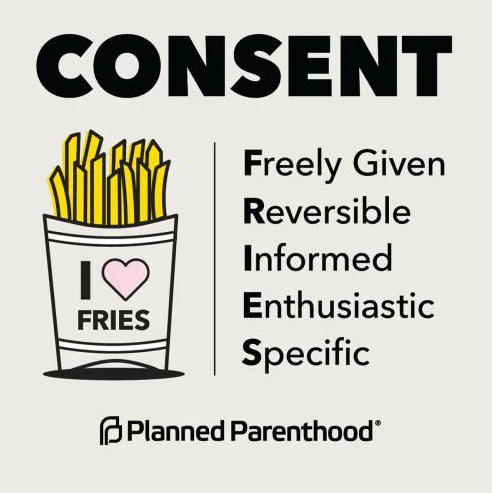
Most of us are familiar with consent. Phrases like “no means no” and movements like #MeToo have gained much traction in recent years. Consent is essentially someone’s permission to engage in an activity. Though we usually use the phrase in regards to sex, someone also needs consent to kiss, touch, or any other intimate activity.
Consent is something that continues throughout the sexual encounter. It is not a one-time thing that you haphazardly ask about in the beginning and never think about again. Making sure that your partner is enjoying themselves using body language/non-verbal cues is one way to make sure they still want to do this. If you notice their body language or something about their behavior has changed, make sure to stop and check-in. Consent requires active listening and paying attention to both verbal and non-verbal cues. Additionally, if you want to slow down, try something else instead, or stop entirely, make sure to tell your partner.
There are both verbal and non-verbal ways to give consent, but either way, it should be obvious that the person is enthusiastically willing to engage in the activity in question. This could be things like saying yes, kissing/touching back, or other physical cues to let their partner know they’re interested. Consent should be given freely and without coercion. Someone who is intoxicated, asleep, unconscious, or underage can never give consent.
Consent also varies based on what is being done. Consenting to one thing in the bedroom is not consent for a different activity. For example, consenting to oral sex does not inherently mean they’re willing to have vaginal sex. This extends to any kink as well. Always ask a partner if they would be comfortable with an activity before doing it. Additionally, have a conversation about boundaries and how far you’re both willing to go.
Consent can be taken away at any time. Just because someone said yes in the beginning does not mean they have to continue if they don’t want to. Sometimes, withdrawing consent can be difficult to do verbally, so it’s a good idea to set up non-verbal ways to check-in with each other during sex.
Body language can show someone’s comfort level. If they are holding back or otherwise look uncomfortable, make sure to check in with them. You can do this by asking if they’re okay, if they want to stop, or if they want to slow down. Whatever their answer is, it’s important to respect how they feel.
Establishing a safeword before you and your partner(s) start is crucial. This should be something that’s easy to remember and not something that’s typically said during sex. Safewords are an easy way to quickly communicate wanting to stop. When the safeword is said, all partners immediately stop whatever they are doing and check-in with each other.
While safewords are a great idea, they are often not the only way people communicate that they want to stop immediately during sex. Many people use non-verbal cues as well, such as tapping your partner three times, using certain gestures, or having a bell on the nightstand that you ring if you want to stop. Regardless of the method, make sure all partners agree on it and are aware of what it means!
The information on this site is for educational purposes only. It does not replace a personal relationship with a licensed health care provider and is not intended to provide medical advice. We strongly recommend that you make your health care decisions based on your own research and knowledge of your body, in collaboration with one or more licensed health care providers.
The hosting for this website is provided by SUNY Geneseo as a courtesy, but it is not an official College publication. The statements and opinions expressed in content of this website do not represent the official position or policy of SUNY Geneseo.